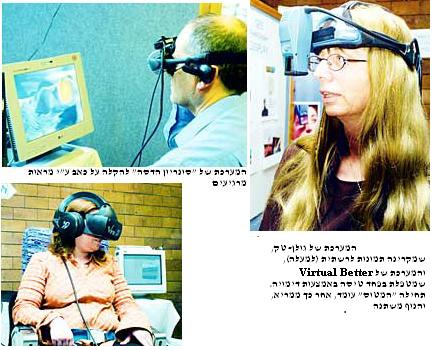Technology / the therapist from the machine
Yuval Dror

Direct link to this page: https://www.hayadan.org.il/psicom.html
How do you treat a person who suffers from social anxiety? Or in a person who suffers from flight anxiety? Until now, the therapists were required to recreate the moments of fear so that they could, together with the person suffering from the anxiety, treat them. In recent years, developments based on virtual reality technologies have appeared, which make it possible to "put" a person into a virtual environment, make him react to it and thus "flood" problems from which he suffers. Yesterday, at an exhibition organized by the Institute for Interdisciplinary Applications of Computer Science and the Department of Healing and Practice in the Faculty of Welfare and Health Studies at the University of Haifa, about ten companies and independent researchers presented developments based on virtual reality technologies, which are intended for medical and other applications.
The promise inherent in virtual reality technologies has been recognized worldwide for more than a decade, but only a few applications have already become commercial and almost none of them have penetrated the private market.
There are many reasons for this - primarily the high cost of the equipment and the powerful computing power required to simulate a realistic environment in real time.
At this point, most applications are in research and development stages; Some of them operate mainly in universities, research bodies and clinics. The company "Sonrion Hadassah", for example, which is engaged in advanced research in virtual reality, yesterday presented a development designed to relieve pain, by means of digital engines that simulate terrain and water.
"The patient wears the head tracking system, which is integrated with the 'surround' system (surround sound system) and enters a virtual world of water, mountains, snow and soothing music," explains Ehud Dayan, the founder of the company. With every movement the landscape changes as if the person were in a beautiful park. "The system engages the patient's brain and allows him to disconnect from the pain he is experiencing," Dayan explains its therapeutic effect. However, it seems that it will not replace the painkillers soon - Dayan emphasizes that it is still in the development stages.
In the applications developed by Prof. Albert "Skip" Rizzo from the University of Southern California, the emphasis is on helping people in need of rehabilitation. Among other things, Rizzo and his team developed a tool that allows a student suffering from attention disorders to be placed in a virtual classroom, with a teacher and students. Rizzo can decide where the student "sits", what types of distractions will be around and how often. The way the student reacts to the simulated disorders should facilitate his diagnosis and treatment.
Also in the field of dealing with anxiety, the researchers of these technologies want to develop aids for treatment. So, for example, another application by Rizzo and his team that is intended for people suffering from social anxiety, for example when meeting people at a party. In this case too, a special helmet with eyepieces is worn on the patient. These show a situation where different people approach the patient and talk to him. "The goal is to increase the level of anxiety, to bring the patient who is being treated to a situation that he encounters on a daily basis, so that the therapist can help him - and on the other hand, to put him in a safe environment where there are no immediate consequences for his reaction," explains Rizzo.
Development for similar purposes is also done at the Virtual Better company, and costs several tens of thousands of dollars. Criminologist Dr. Helen Wallach and psychologist Dr. Margalit Bar-Zvi intend to purchase it and start implementing it at the University of Haifa, to treat crowd anxiety. "This is classic behavioral therapy. Usually we needed volunteers to sit in the room and make plays in front of the patient. Now, the problem is solved", she explains.
Dr. Wallach yesterday presented another system from the company Virtual Better, which treats, among other things, the fear of flying, which comprehensively simulates the experience: the person wears a helmet, and he sits in the passenger seat of an airplane. First the "plane" stops, then it starts traveling on the runway and then takes off. The view that the person sees in the helmet changes and the chair also shakes. However, the developers admit that the image of the flight experience is not complete: the system may help to overcome the fear, but still does not allow purchases at duty-free.
Yuval Dror
Instead of a monitor: the data reaches the retina
Danny Golan, CEO of the Golan-Tech company, presented yesterday, at an exhibition organized by the Institute for Interdisciplinary Applications of Computer Science at the University of Haifa, a development in which Air Force planes were also used. This is a system that is worn on the pilot's head and shows one of his eyes the data of the plane's systems (see photo). About two centimeters from the helmet is a transparent mirror that transmits the image directly to the retina. This way the pilot can look outside the plane and at the same time continue to see what the state of the plane is.
Most of the company's revenue comes from the defense system, but Golan explains that the technology also has civilian applications. "In this way, a surgeon can see medical data without taking his eyes off the patient and without a nurse playing it in his ears," he says, detailing another possible application: "Since the transparent mirror presents the data directly to the retina, it can be used to display a video game, while the images that are normally displayed On the TV screen, they are transmitted directly to the retina of the eye."
https://www.hayadan.org.il/BuildaGate4/general2/data_card.php?Cat=~~~801638140~~~65&SiteName=hayadan
